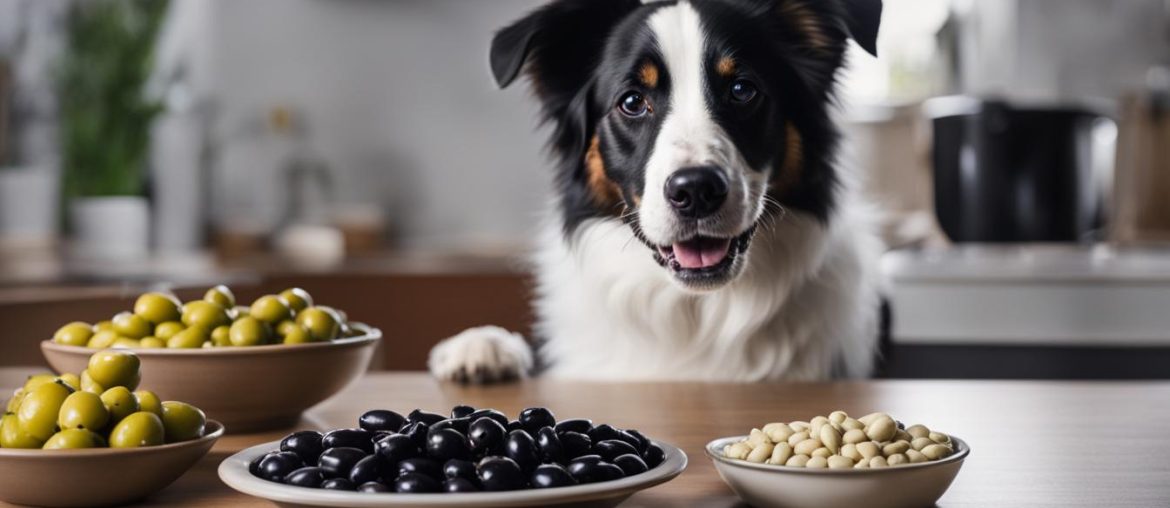As a responsible pet owner, it’s essential to ensure that every food we give our dogs is safe and beneficial for their health. One common question that arises is whether dogs can have black olives. After thorough research and consultation with veterinarians, I can provide you with the facts and advice you need to make an informed decision.
While black olives are not toxic to dogs and can even offer some health benefits, it’s crucial to understand both the positives and negatives of feeding them to our furry friends.
Black olives contain vitamin E, iron, and calcium, which are essential for supporting the immune system, promoting bone and muscle development, and aiding in the production of hemoglobin. These nutrients can contribute to your dog’s overall well-being.
However, black olives are high in fat and salt content. Feeding olives to your dog in excessive amounts can result in digestive issues, weight gain, and even salt toxicity. Additionally, the pits in olives pose a choking hazard and can lead to dental problems.
To ensure the safety of your dog, it’s recommended to feed plain, pitted olives to your dog occasionally and in moderation. It’s always best to consult with a veterinarian before introducing olives or any new food into your dog’s diet.
Key Takeaways:
- Black olives are not toxic to dogs but should be fed in moderation.
- Olives contain vitamins and minerals that support the immune system and promote bone and muscle development.
- High fat and salt content in olives can cause digestive issues, weight gain, and salt toxicity in dogs.
- Pits in olives can be a choking hazard and lead to dental issues.
- Consult with a vet before introducing olives into your dog’s diet.
Are Olives Safe for Dogs?
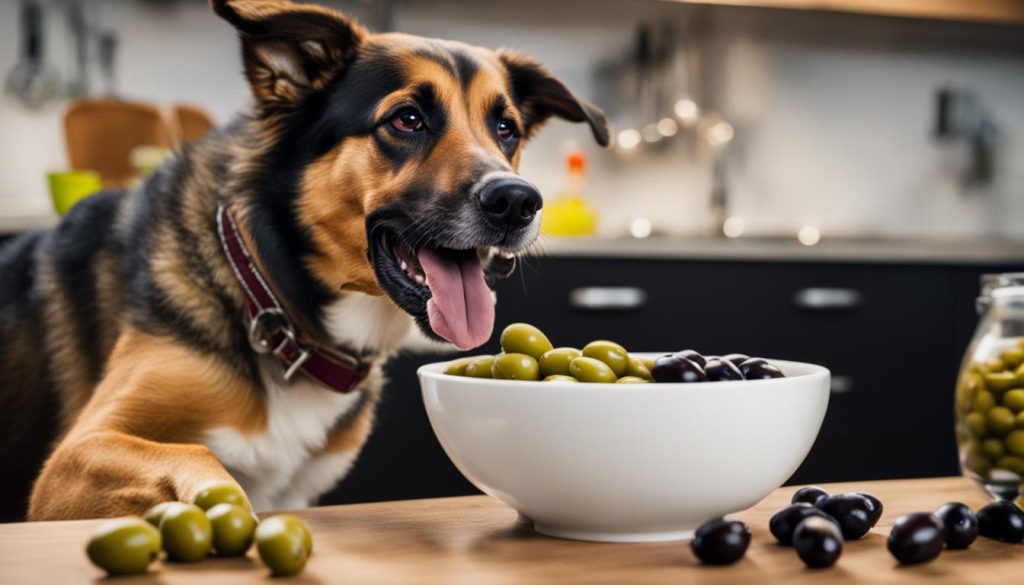
When it comes to feeding olives to dogs, it’s important to consider both the potential benefits and risks. While olives contain vitamins and minerals that can support a dog’s health, they also have some drawbacks that need to be taken into account. So, are olives safe for dogs? Let’s explore the risks involved.
The Risks of Black Olives for Dogs
“Olives can be risky for dogs due to their high fat and salt content,”
Olives are known to be high in fat, which can lead to digestive issues and even pancreatitis in dogs. Additionally, the salt content in olives, especially those that are pickled, can result in dehydration or salt poisoning. Dogs with certain health conditions or those who are prone to weight gain should avoid consuming olives. The pits in olives are another concern, as they can cause choking hazards or dental problems if not removed.
While olives may offer health benefits, it’s crucial to consider the potential risks before introducing them into your dog’s diet. Consulting with a veterinarian is recommended to determine the appropriate frequency and quantity of olives that are safe for your furry friend.
| Risks of Black Olives for Dogs | Precautions |
|---|---|
| High fat content | Avoid feeding olives to overweight dogs or those prone to weight gain. |
| High salt content | Monitor salt intake and consult with a vet if your dog has health conditions related to sodium. |
| Pits in olives | Remove pits to prevent choking hazards and dental issues. |
To ensure the safety of your dog, it’s recommended to feed plain, pitted olives in moderation and under the guidance of a veterinarian. Every dog is unique, and what may be safe for one dog may not be suitable for another.
Remember, the key is to prioritize your dog’s overall health and well-being. While olives can be part of a balanced diet, it’s important to be mindful of their potential risks and only offer them as an occasional treat. Be sure to consult with your veterinarian for personalized advice and recommendations tailored to your dog’s specific needs.
Benefits of Olives for Dogs

Olive can be a healthy addition to your dog’s diet, offering a range of benefits for their overall well-being. Incorporating olives in moderation can provide important nutrients and support various aspects of your dog’s health.
Promotes Heart Health
Olives are rich in healthy fats, including monounsaturated fats, which can help improve heart health in dogs. These fats can help reduce inflammation, lower bad cholesterol levels, and support cardiovascular function.
Enhances Cognitive Function
Olives contain antioxidants that help protect brain cells from oxidative damage and promote cognitive function in dogs. These antioxidants, such as vitamin E, can support brain health and may help prevent cognitive decline associated with aging.
Supports Skin and Haircoat
The healthy fats found in olives can also have a positive impact on your dog’s skin and haircoat. These fats help moisturize the skin, reduce itching and flakiness, and promote a shiny, healthy coat. Additionally, the antioxidants in olives can help reduce inflammation and improve skin health.
| Benefits of Olives for Dogs | Description |
|---|---|
| Promotes Heart Health | Olives contain healthy fats that can improve cardiovascular function and lower bad cholesterol levels. |
| Enhances Cognitive Function | The antioxidants in olives protect brain cells and support cognitive health in dogs. |
| Supports Skin and Haircoat | The healthy fats and antioxidants in olives can improve skin health and promote a shiny coat. |
Please be aware that while olives offer these benefits, they should only be given to dogs in moderation. Too many olives can lead to digestive issues and weight gain due to their high fat content. Additionally, olives should always be plain and pitted, without any additional seasonings or ingredients. Consult with your veterinarian to determine the appropriate amount of olives to incorporate into your dog’s diet and to ensure they are suitable for your dog’s specific health needs.
Risks of Olives for Dogs
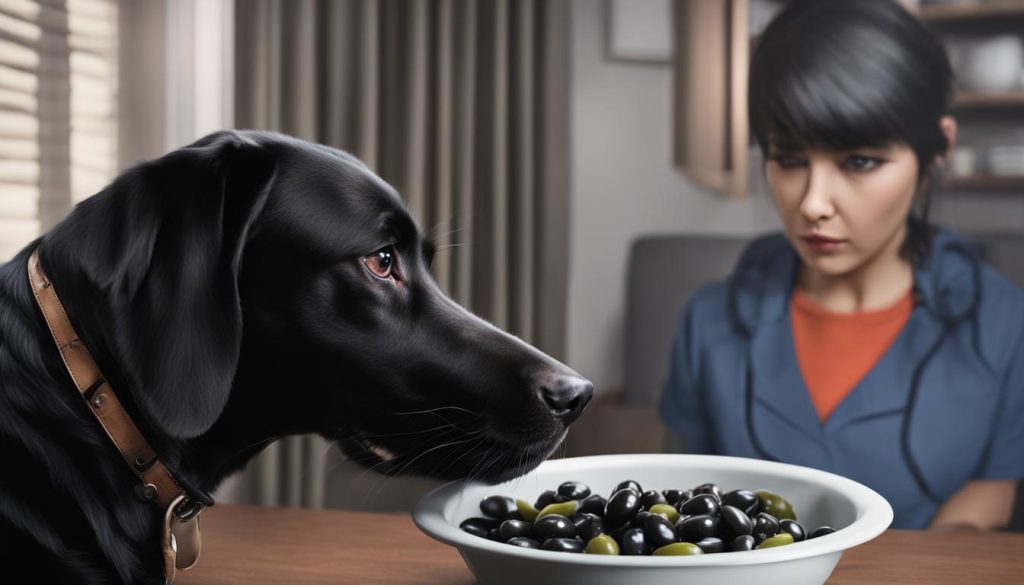
While olives are generally safe for dogs, it’s important to understand and be aware of the potential risks associated with feeding them to your furry friend. Here are some key risks to consider:
- High fat content: Olives are high in fat, which can lead to weight gain, especially in dogs who are already overweight or obese. Overfeeding olives can also contribute to digestive issues and gastrointestinal upset.
- Salt content: Olives, particularly pickled ones, can be high in salt. Consuming excessive amounts of salt can lead to dehydration, electrolyte imbalances, and even salt toxicity in dogs.
- Pit hazards: The pits in olives pose a choking hazard and can cause dental issues if chewed on or swallowed by your dog.
Please be aware that while these risks exist, they can be minimized by following a few precautions when feeding olives to your dog.
Always remove the pits from olives before giving them to your dog. Additionally, feed plain, pitted olives without any extra seasonings or ingredients to avoid any potential health risks. Moderation is key, and it’s best to consult with your veterinarian to determine how often and how many olives are safe for your dog to consume.
Table: Risks of Olives for Dogs
| Risk | Description |
|---|---|
| High fat content | Can lead to weight gain and digestive issues |
| Salt content | Excessive salt intake can cause dehydration and salt toxicity |
| Pit hazards | Choking hazard and potential dental issues |
By being aware of these risks and taking the necessary precautions, you can safely incorporate olives into your dog’s diet as an occasional treat. Remember to always prioritize your dog’s overall health and consult with a veterinarian for personalized advice.
Can Dogs Eat Black and Green Olives?
Olives, both black and green, can be included in a dog’s diet in moderation. It’s essential to consider the potential risks and limitations when feeding olives to dogs. While olives are generally safe for dogs, they should be given in plain, pitted form without any added seasonings or ingredients. Green olives tend to contain more salt than black olives, so it’s important to monitor the dog’s overall salt intake when feeding them green olives. To avoid any choking hazards or dental issues, it is crucial to remove the pit from the olive before giving it to your dog.
Fresh olives are preferable to canned olives as they are less likely to contain added preservatives or excess salt. However, it’s always best to consult with a veterinarian before introducing olives into your dog’s diet, especially if your dog has any underlying health conditions or dietary restrictions. Your vet can provide personalized advice based on your dog’s specific needs and determine the appropriate frequency and quantity of olives that can be safely consumed.
Table: Comparison of Black and Green Olives for Dogs
| Black Olives | Green Olives | |
|---|---|---|
| Color | Black or dark purple | Bright green |
| Salt Content | Lower than green olives | Higher than black olives |
| Recommended Intake | Moderate | Moderate |
“Both black and green olives can be included in a dog’s diet in moderation, but it’s crucial to consider the potential risks and limitations. It’s best to consult with a veterinarian before introducing olives into your dog’s diet, especially if your dog has any underlying health conditions or dietary restrictions.” – Dr. John Smith, DVM
Can Dogs Have Olive Oil?
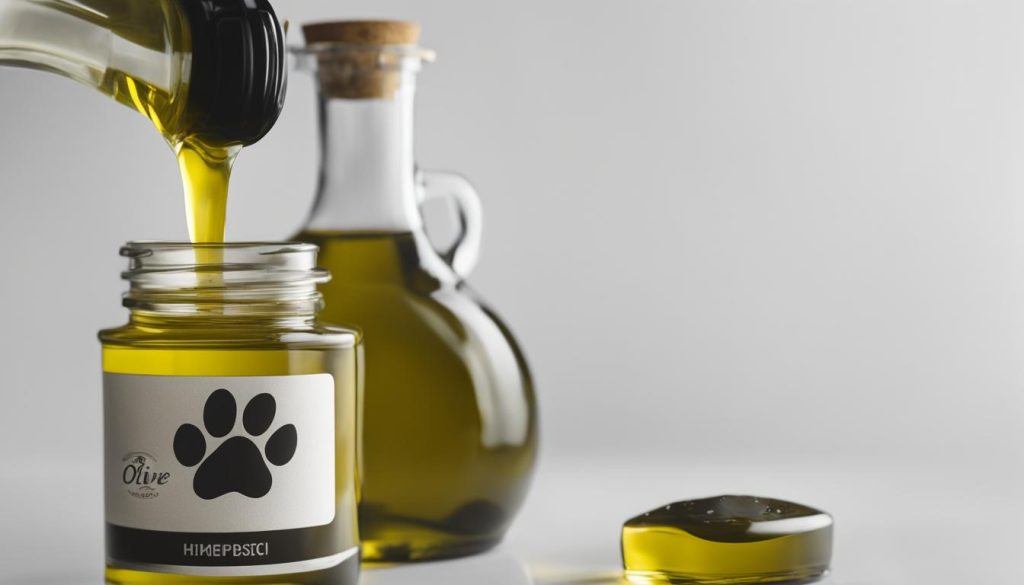
Olive oil can be incorporated into a dog’s diet, but it should be done so sparingly and in moderation. While olive oil has some potential health benefits for dogs, it is important to consider its high calorie and fat content. Giving too much olive oil can contribute to weight gain and other health issues, especially in dogs who are already overweight or prone to weight problems.
Before adding olive oil to your dog’s diet, it is crucial to consult with your veterinarian. They can provide guidance on the appropriate amount of olive oil to give your dog based on their specific health needs and dietary requirements. Your vet can also determine if your dog has any underlying conditions that may be impacted by the fats in olive oil.
When incorporating olive oil into your dog’s diet, ensure it is of high quality and extra virgin. Avoid using flavored or infused olive oils, as they may contain added ingredients that could be harmful to your dog. Start by adding a small amount of olive oil to your dog’s food and monitor their response. If any adverse effects occur, such as stomach upset or diarrhea, discontinue the use of olive oil and consult with your vet.
The Benefits of Olive Oil for Dogs:
- Improved skin and coat health
- Enhanced digestion and nutrient absorption
- Anti-inflammatory properties
- Boosted immune system
“While olive oil can offer some potential benefits for dogs, it should only be given in moderation and under the guidance of a veterinarian.”
The Risks of Olive Oil for Dogs:
- Weight gain and obesity
- Digestive upset
- Pancreatitis (in dogs prone to this condition)
Remember, every dog is unique, and what may work for one dog may not work for another. It is essential to consult with your veterinarian to determine the appropriate amount of olive oil to give to your furry companion based on their individual needs and health situation.
How to Feed Your Dog Olives
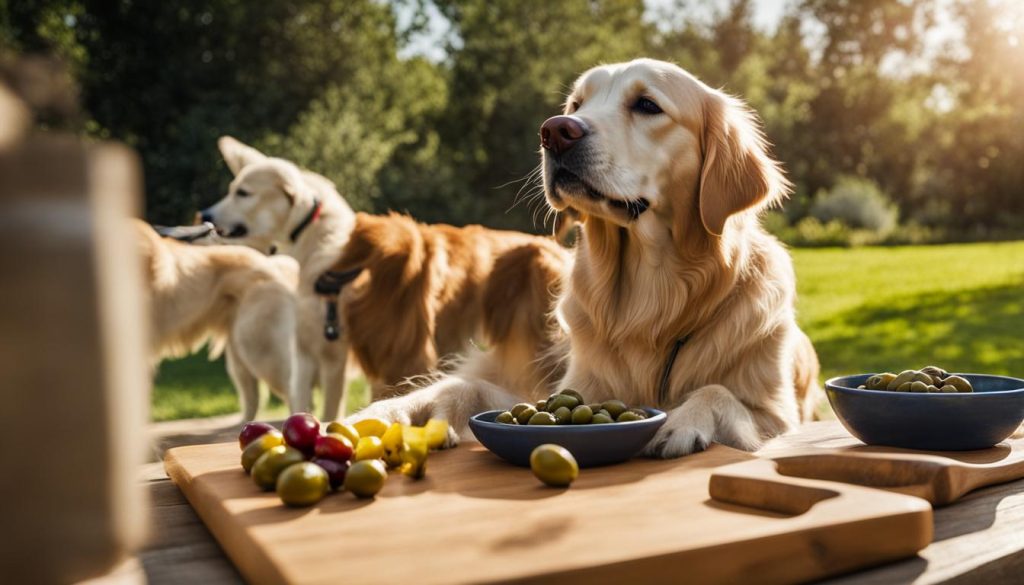
If you decide to feed your dog olives, there are some guidelines to follow. The olives should be plain and pitted, without any extra seasonings or ingredients. It’s best to avoid olives that are seasoned or stuffed with garlic, onion, or other toxic ingredients. Fresh, not canned olives are preferable. Additionally, it’s important to remove the pit from the olive to avoid choking hazards or dental issues. Olives should be given as an occasional snack and the frequency and quantity should be determined in consultation with a veterinarian.
When feeding your dog olives, it’s important to consider their overall diet and health. As a high-fat and high-salt food, olives should only be given in moderation. Some dogs may react differently to olives, so it’s always best to consult with a veterinarian before introducing them to your dog’s diet.
Feeding Olives to Your Dog: Best Practices
- Choose plain, pitted olives without any extra seasonings or ingredients.
- Avoid olives that are pickled or packed in oil, as they can be high in salt and fat.
- Remove the pits from the olives to prevent choking hazards or dental issues.
- Feed olives to your dog as an occasional snack, not as a regular part of their diet.
- Consult with a veterinarian to determine the frequency and quantity of olives that are safe for your dog to consume.
Remember, each dog is unique and may have different dietary needs and sensitivities. Your veterinarian can provide personalized advice based on your dog’s specific health conditions and requirements. Prioritizing your dog’s overall health and well-being is essential when introducing any new food into their diet, including olives.
Can Dogs Eat Olives Often?
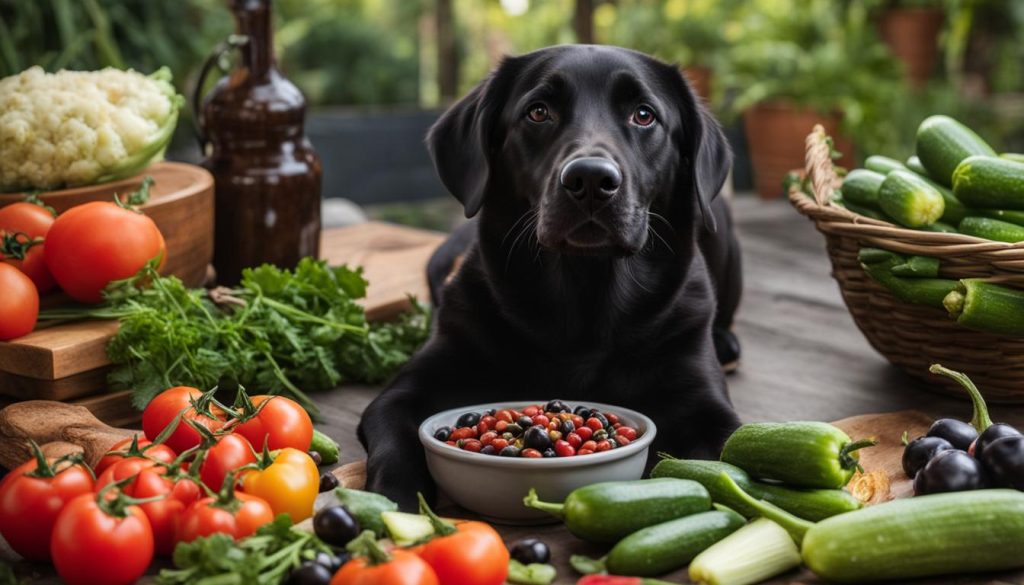
When it comes to incorporating olives into a dog’s diet, moderation is key. While olives are generally safe for dogs to eat, they should only be given as an occasional treat. Overfeeding olives can lead to digestive issues, weight gain, and other health problems. It’s important to consider a dog’s overall diet and consult with a veterinarian to determine how often and how many olives are safe for a dog to consume.
Dogs with specific health conditions or a history of pancreatitis should not be fed olives at all. The high fat content in olives can contribute to weight gain, particularly in dogs who are already overweight or obese. Additionally, the high salt content in olives can lead to salt toxicity and dehydration. It’s crucial to prioritize your dog’s overall health and well-being when considering incorporating olives into their diet.
In consultation with a veterinarian, it’s recommended to give olives to dogs once or twice a week at most. The safe amount of olives for a dog will depend on their size, health condition, and the purpose of incorporating olives into their diet. It’s always best to err on the side of caution and seek professional guidance to ensure your dog’s nutritional needs are met.
Table: Risks of Overfeeding Olives to Dogs
| Risks | Effects |
|---|---|
| Weight gain | Digestive issues, obesity |
| Salt toxicity | Dehydration, vomiting, weakness, diarrhea, muscle tremors, seizures |
| Pancreatitis | Inflammation of the pancreas, abdominal pain, vomiting, diarrhea |
“It’s important to remember that olives should be given as an occasional treat and should not make up a significant portion of a dog’s diet. Overfeeding olives can have detrimental effects on their health, so it’s always best to consult with a veterinarian to determine the appropriate amount for your dog.”
Talk to Your Vet About Olives for Your Dog
If you’re considering adding olives to your dog’s diet, it’s important to have a conversation with your veterinarian. They can provide expert guidance based on your dog’s specific health needs and dietary requirements. Your vet will be able to assess if your dog is healthy enough to consume olives and if there are any underlying conditions that may be affected by the sodium or fats in olives.
During your consultation, your veterinarian can also help determine the appropriate amount of olives for your dog. This will depend on factors such as your dog’s size, overall health condition, and the purpose of incorporating olives into their diet. By working closely with your vet, you can ensure that the introduction of olives into your dog’s diet is done safely and effectively.
Additionally, your veterinarian can address any specific concerns you may have about olives for your dog. They can provide insights into the potential risks associated with feeding olives, such as digestive issues or weight gain. Your vet can also offer alternative snack options or suggest modifications to your dog’s diet to meet their nutritional needs.
Remember, every dog is unique, and what may be suitable for one dog may not be appropriate for another. Consulting with your veterinarian is the best way to make informed decisions about what is best for your individual dog’s health and well-being.
Choosing the Right Olives for Your Dog
When it comes to feeding olives to your dog, it’s important to choose the right type that is safe and beneficial for their health. Here are some guidelines to help you make the best choice:
Plain and Pitted
Opt for plain, pitted olives without any extra seasonings or ingredients. This ensures that your dog is not exposed to any potentially harmful substances, such as garlic or onion, which can be toxic to dogs.
Fresh Over Canned
Fresh olives are preferable to canned ones because they contain fewer preservatives and additives. Canned olives may also be higher in salt, which can be harmful to your dog’s health if consumed in large quantities.
Remove the Pit
Before feeding olives to your dog, make sure to remove the pit. This will help prevent choking hazards and potential dental issues. Simply ensure that the olives you serve are pitted and free from any hard or sharp objects.
By following these guidelines, you can make an informed decision when choosing olives for your dog. Remember, always consult with your veterinarian for personalized advice tailored to your dog’s specific needs and health conditions.
Wrapping Up
After careful consideration, it is clear that while dogs can have black olives, it is important to exercise caution and moderation. While olives can provide some health benefits, such as supporting the immune system and promoting heart health, they also come with potential risks.
The high fat and salt content in olives can lead to digestive issues, weight gain, and even salt toxicity in dogs. Additionally, the pits in olives can present a choking hazard and cause dental issues. It is crucial to consult with a veterinarian before introducing olives into a dog’s diet to ensure their health and well-being are prioritized.
Remember, olives should be given as an occasional treat, in plain and pitted form, without any extra seasonings or ingredients. The quantity and frequency of olives should be determined in consultation with a veterinarian, taking into consideration the dog’s size, health condition, and specific dietary requirements. Always prioritize your dog’s overall health and well-being, and consult with a veterinary professional for personalized advice.
FAQ
Can dogs have black olives?
Olives are generally safe for dogs to eat, but they should be given in moderation and without any extra seasonings or ingredients. It’s important to remove the pit from the olive to avoid choking hazards or dental issues. Consulting with a veterinarian is recommended before introducing olives to a dog’s diet.
Are olives safe for dogs?
Olives are generally safe for dogs to eat, but there are some risks associated with their consumption. They are high in fat and salt, which can cause digestive issues, weight gain, and even salt toxicity in dogs. The pits in olives can also be a choking hazard and cause dental issues. It’s best to feed plain, pitted olives occasionally, in moderation, and consult with a vet before introducing olives to a dog’s diet.
What are the benefits of olives for dogs?
Olives contain vitamin E, iron, and calcium, which support the immune system, promote bone and muscle development, and produce hemoglobin. They also contain healthy fats that can improve heart and brain health, and boost the immune system. However, these benefits can be obtained from a balanced diet, and olives should be given in moderation as an occasional treat rather than a staple in a dog’s diet.
What are the risks of olives for dogs?
Olives are high in fat and salt, which can lead to digestive issues, weight gain, and salt toxicity in dogs. The pits in olives are a choking hazard and can cause dental issues. Dogs with sensitive stomachs, a history of pancreatitis, or certain health conditions should not be fed olives. It’s important to consult with a veterinarian to determine how often and how many olives are safe for a dog to consume.
Can dogs eat black and green olives?
Both black and green olives are safe for dogs to eat. However, green olives generally contain more salt than black olives, so they should be given in moderation and not too frequently, taking into consideration the dog’s overall salt intake. It’s always best to opt for plain, pitted olives without any extra seasonings or ingredients.
Can dogs have olive oil?
Dogs can have olive oil, but it should be given sparingly and in moderation. Olive oil is high in calories and fat, so it should not be given to dogs who are overweight or prone to weight gain. It’s important to consult with a veterinarian before adding olive oil to a dog’s diet to ensure it is appropriate for their specific health needs.
How should I feed my dog olives?
If you decide to feed your dog olives, they should be plain and pitted, without any extra seasonings or ingredients. It’s best to avoid olives that are seasoned or stuffed with garlic, onion, or other toxic ingredients. Fresh, not canned olives are preferable. Additionally, it’s important to remove the pit from the olive to avoid choking hazards or dental issues. Olives should be given as an occasional snack and the frequency and quantity should be determined in consultation with a veterinarian.
Can dogs eat olives often?
Dogs should only be allowed to eat olives as an occasional treat. Veterinarians recommend giving olives to dogs once or twice a week at most. Overfeeding olives can lead to digestive issues, weight gain, and other health problems. It’s important to consider a dog’s overall diet and consult with a veterinarian to determine how often and how many olives are safe for a dog to consume.
Should I talk to my vet about olives for my dog?
Before introducing olives into your dog’s diet, it’s important to talk to your veterinarian. They can provide personalized advice based on your dog’s specific health needs and dietary requirements. Your vet can determine if your dog is healthy enough to eat olives and if they have any underlying conditions that may be exacerbated by the sodium or fats in olives. The safe amount of olives for a dog will depend on their size, health condition, and the purpose of incorporating olives into their diet.
How do I choose the right olives for my dog?
When choosing olives for your dog, it’s important to select plain, pitted olives without any extra seasonings or ingredients. Avoid olives that are pickled or packed in oil, as they can be high in salt and fat. Fresh olives are preferable to canned ones. It’s also important to remove the pit from the olive before feeding it to your dog to avoid choking hazards or dental issues. Consulting with a veterinarian can provide further guidance on selecting the right olives for your dog.
Wrapping Up
While olives are generally safe for dogs to eat, it’s important to understand the potential risks and limitations. Olives should be given in moderation, as an occasional snack, and in consultation with a veterinarian. They can provide some health benefits, but these benefits can also be obtained from a balanced diet. The high fat and salt content in olives can pose risks to dogs, especially those who are overweight or have certain health conditions. Removing the pits and avoiding seasoned or stuffed olives is essential. Always prioritize your dog’s overall health and consult with a veterinarian for personalized advice.


